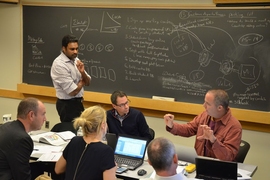You know that person who always seems to be ahead of their deadlines, despite being swamped? Do you look at them with envy and wonder how they do it?
"Regardless of location, industry, or occupation, productivity is a challenge faced by every professional," says Robert Pozen, senior lecturer at the MIT Sloan School of Management.
As part of his ongoing research and aided by MIT undergraduate Kevin Downey, Pozen surveyed 20,000 self-selected individuals in management from six continents to learn why some people are more productive than others.
The survey tool, dubbed the Pozen Productivity Rating, consists of 21 questions divided into seven categories: planning your schedule, developing daily routines, coping with your messages, getting a lot done, improving your communication skills, running effective meetings, and delegating to others. These particular habits and skills are core to Pozen’s MIT Sloan Executive Education program, Maximizing Your Productivity: How to Become an Efficient and Effective Executive, and his bestselling book, "Extreme Productivity: Boost Your Results, Reduce Your Hours."
After cleaning up the data, Pozen and Downey obtained a complete set of answers from 19,957 respondents. Roughly half were residents of North America; another 21 percent were residents of Europe, and 19 percent were residents of Asia. The remaining 10 percent included residents of Australia, South America, and Africa.
They identified the groups of people with the highest productivity ratings and found that professionals with the highest scores tended to do well on the same clusters of habits:
- They planned their work based on their top priorities and then acted with a definite objective;
- they developed effective techniques for managing a high volume of information and tasks; and
- they understood the needs of their colleagues, enabling short meetings, responsive communications, and clear directions.
The results were also interesting when parsed by the demographics of the survey participants.
Geographically, the average productivity score for respondents from North America was in the middle of the pack, even though Americans tend to work longer hours. In fact, the North American score was significantly lower than the average productivity scores for respondents from Europe, Asia, and Australia.
Age and seniority were highly correlated with personal productivity — older and more senior professionals recorded higher scores than younger and more junior colleagues. Habits of these more senior respondents included developing routines for low-value activities, managing message flow, running effective meetings, and delegating tasks to others.
While the overall productivity scores of male and female professionals were almost the same, there were some noteworthy differences in how women and men managed to be so productive. For example, women tended to score particularly high when it came to running effective meetings — keeping meetings to less than 90 minutes and finishing with an agreement of next steps. By contrast, men did particularly well at coping with high message volume — not looking at their emails too frequently and skipping over the messages of low value.
Coping with your daily flood of messages
While it’s clear that the ability to deal with inbox overload is key to productivity, how that’s accomplished may be less clear to many of us who shudder at our continuous backlog of emails.
“We all have so much small stuff, like email, that overwhelms us, and we wind up dedicating precious time to it,” says Pozen. “Most of us look at email every three to five minutes. Instead, look every hour or two, and when you do look, look only at subject matter and sender, and essentially skip over 60-80 percent of it, because most emails you get aren’t very useful.” Pozen also encourages answering important emails immediately instead of flagging them and then finding them again later (or forgetting altogether), as well as flagging important contacts and making ample use of email filters.
However, Pozen stresses that managing incoming emails, while an important skill, needs to be paired with other, more big-picture habits in order to be effective, such as defining your highest priorities. He warns that without a specific set of goals to pursue — both personal and professional — many ambitious people devote insufficient time to activities that actually support their top goals.
More tips for maximizing your productivity
If you want to become more productive, try developing the “habit clusters” demonstrated in Pozen’s survey results and possessed by the most productive professionals. This includes:
- Focusing on your primary objectives: Every night, revise your next day’s schedule to stress your top priorities. Decide your purpose for reading any lengthy material, before you start.
- Managing your work overload: Skip over 50-80 percent of your emails based on the sender and the subject. Break large projects into small steps — and start with step one.
- Supporting your colleagues: Limit any meeting to 90 minutes or less and end each meeting with clearly defined next steps. Agree on success metrics with your team.
Pozen's survey tool is still available online. Those completing it will receive a feedback report offering practical tips for improving productivity. You can also learn from Pozen firsthand in his MIT Executive Education program, Maximizing Your Personal Productivity.







